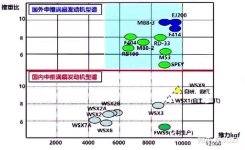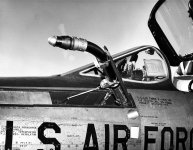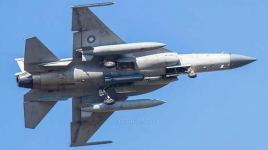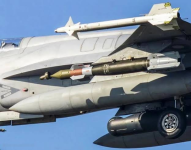Couldnt find any info on B-REK @farooqbhai @Quwa @Windjammer @Awwad any insight?Boosted Anti Radiation Rek ?
View attachment 67486
Navigation
Install the app
How to install the app on iOS
Follow along with the video below to see how to install our site as a web app on your home screen.
Note: This feature may not be available in some browsers.
More options
Style variation
You are using an out of date browser. It may not display this or other websites correctly.
You should upgrade or use an alternative browser.
You should upgrade or use an alternative browser.
JF-17 - Updates, News & Discussion
- Thread starter ghazi52
- Start date
It could be the Qaswa AZB-V or AZB-VI.
Michael
VIP Member
- Jan 5, 2024
- 611
- 939
- Country of Origin

- Country of Residence

I'm going to provide you with two images to think about.If JF17 PFX…is a thing…
…my guess would be a future version with WS19 engine rather than RD93(assuming WS19 has demonstrated it’s reliability and is significantly more powerful by that future time).
With the WS19…maybe a slightly larger body of the aircraft to make full use of extra thrust of WS19…along with upgraded avionics(like liquid cooled AESA with more TRMs)
…and perhaps more focus on integrating locally produced munitions.


This is a screenshot of Chief Designer Huang's speech at the China Aviation Propulsion Technology Forum 2022.
As a side note: the WS19 has been fitted to the J35 and is being scaled up for production.
What makes you think that?I doubt the Chinese would want it…so it would go similar route to a JF17…as in PAF acquiring it to replace older aircrafts(which I assume would be F16s at the time).
PLAAF has always disliked light fighters, they favor heavy. Among the PLAAF's active fighters, the J10 series is among the lowest configurations, except for a handful of older fighters that are already in the decommissioning process. If it were not for economic factors, the PLAAF would not want the J10.
This factor also affects the J31, which the PLAAF does not like, and which has no advantages over the J20 and is not much cheaper than the J20. Without orders from PLAAF, the J31 has never been able to start production on a large scale. the amount of orders from PAF is obviously not enough to start the production line.
However, I mentioned an idea before. If the JF-17B was upgraded to a 5th generation stealth two-seater version, it would definitely sell. There are no similar products or plans in the world.
FOOLS_NIGHTMARE
Elite Member
- Sep 25, 2018
- 26,573
- 42,524
- Country of Origin

- Country of Residence

FOOLS_NIGHTMARE
Elite Member
- Sep 25, 2018
- 26,573
- 42,524
- Country of Origin

- Country of Residence

FuturePAF
THINK TANK: CONSULTANT
- Dec 17, 2014
- 12,793
- 12,215
- Country of Origin

- Country of Residence

Any indication the PAF will work on a retractable inflight refueling probe? Something akin to the Tornado’s IFR probe or that on the J-20?
Considering the tech has already been developed for the J-20 and will invariably be put on the J-31/35, putting a similar system on the JF-17 and J-10 will help lower RCS and improve the aerodynamic performance. It’s a technology that would be needed if the PFX is minimize the RCS, so developing it for the JF-17 will help not just future projects but the majority of the current fleet.
If the PAF also wants to develop a UCAV from a fighter this sized and sell it on to PLAAF (as a sub-contractor with Chengdu perhaps) or for export. The demands for atritable UCAVs will likely be large, so Pakistan will have a lot of contracts to bid for.

Considering the tech has already been developed for the J-20 and will invariably be put on the J-31/35, putting a similar system on the JF-17 and J-10 will help lower RCS and improve the aerodynamic performance. It’s a technology that would be needed if the PFX is minimize the RCS, so developing it for the JF-17 will help not just future projects but the majority of the current fleet.
If the PAF also wants to develop a UCAV from a fighter this sized and sell it on to PLAAF (as a sub-contractor with Chengdu perhaps) or for export. The demands for atritable UCAVs will likely be large, so Pakistan will have a lot of contracts to bid for.

Last edited:
Michael
VIP Member
- Jan 5, 2024
- 611
- 939
- Country of Origin

- Country of Residence

The refueling probe is either externally fixed or internally telescopic, depending on the choice of head design. There are no technical problems.Any indication the PAF will work on a retractable inflight refueling probe? Something akin to the Tornado’s IFR probe or that on the J-20?
Considering the tech has already been developed for the J-20 and will invariably be put on the J-31/35, putting a similar system on the JF-17 and J-10 will help lower RCS and improve the aerodynamic performance. It’s a technology that would be needed if the PFX is minimize the RCS, so developing it for the JF-17 will help not just future projects but the majority of the current fleet.
View attachment 68417
Any design work is a play on the art of balance. Based on the design specifications, the best choice is made from the arsenal of technical modules already at your disposal.
The JF17 fuselage is so small that it is approaching the limits of its internal space usage. It doesn't have enough internal space to accommodate a built-in telescopic refueling probe.
You'd be surprised when you carefully compare the size of the JF-17 and the J20.
Cookie Monster
Senior Member
- Oct 30, 2016
- 4,071
- 6,210
- Country of Origin

- Country of Residence

I think u misunderstood what I said.I'm going to provide you with two images to think about.
View attachment 68211
View attachment 68212
This is a screenshot of Chief Designer Huang's speech at the China Aviation Propulsion Technology Forum 2022.
As a side note: the WS19 has been fitted to the J35 and is being scaled up for production.
What makes you think that?
PLAAF has always disliked light fighters, they favor heavy. Among the PLAAF's active fighters, the J10 series is among the lowest configurations, except for a handful of older fighters that are already in the decommissioning process. If it were not for economic factors, the PLAAF would not want the J10.
This factor also affects the J31, which the PLAAF does not like, and which has no advantages over the J20 and is not much cheaper than the J20. Without orders from PLAAF, the J31 has never been able to start production on a large scale. the amount of orders from PAF is obviously not enough to start the production line.
However, I mentioned an idea before. If the JF-17B was upgraded to a 5th generation stealth two-seater version, it would definitely sell. There are no similar products or plans in the world.
I said exactly the same thing in my post…that China wouldn’t want a fighter like JF17 for its airforce.
This is bcuz China has a large landmass…and its adversaries are a good distance away that would make it hard to tackle with light fighters.
FuturePAF
THINK TANK: CONSULTANT
- Dec 17, 2014
- 12,793
- 12,215
- Country of Origin

- Country of Residence

I know the JF-17 is very small compared to the J-20, but perhaps it need not be fully internal, just like the Panavia Tornado’s probe is hosed in an external conformal housing.The refueling probe is either externally fixed or internally telescopic, depending on the choice of head design. There are no technical problems.
Any design work is a play on the art of balance. Based on the design specifications, the best choice is made from the arsenal of technical modules already at your disposal.
The JF17 fuselage is so small that it is approaching the limits of its internal space usage. It doesn't have enough internal space to accommodate a built-in telescopic refueling probe.
You'd be surprised when you carefully compare the size of the JF-17 and the J20.


Building the tech for the JF-17’s evolution into the PFX could lead to the creation of just large enough UCAV for fly with the J-20 as loyal wingmen.

Last edited:
Michael
VIP Member
- Jan 5, 2024
- 611
- 939
- Country of Origin

- Country of Residence

The J-10 is slightly larger than the JF-17 and also uses an external fixed refueling probe.I know the JF-17 is very small compared to the J-20, but perhaps it need not be fully internal, just like the Panavia Tornado’s probe is hosed in an external conformal housing.
View attachment 68423
View attachment 68425
Building the tech for the JF-17’s evolution into the PFX could lead to the creation of just large enough UCAV for fly with the J-20 as loyal wingmen.
View attachment 68424
Forcing the JF-17 to have a built-in retractable probe would require a complete nose redesign and, at the same time, would require a realignment of the overall aerodynamic profile layout. The cost would be too great.
The JF-17 is a Sino-Pakistani cooperation program for Pakistan and export markets only.
The J-20's loyal wingman has a wide choice of completed programs. the FH-97, GJ-11, etc., and a few more yet to be disclosed. It has a wealth of options.
I still maintain that the JF-17 should be developed as a fifth generation two-seat stealth fighter in the future. It could be returned to the Chinese market as a trainer. Currently, no country, including China, has developed a similar program. If the program is successful, PLAAF will certainly choose to buy it to replace the JL-10.
Pakistan needs to pre-empt the CAC and offer to cooperate in the program. Once a similar program emerges for subsequent upgrades of the JL-10, there is a possibility that CAC may refuse to cooperate on the program as it creates a competitive conflict relationship.
Last edited:
FuturePAF
THINK TANK: CONSULTANT
- Dec 17, 2014
- 12,793
- 12,215
- Country of Origin

- Country of Residence

Fair enough. Also good advice on developing the J-17B further first, as a 5th gen trainer. Perhaps a collaboration with chengdu will prevent CAC from seeing it as competition, and a joint way to develop a trainer for the PLAAF and a fighter for the PAF under the PFX program.The J-10 is slightly larger than the JF-17 and also uses an external fixed refueling probe.
Forcing the JF-17 to have a built-in retractable probe would require a complete nose redesign and, at the same time, would require a realignment of the overall aerodynamic profile layout. The cost would be too great.
The JF-17 is a Sino-Pakistani cooperation program for Pakistan and export markets only.
The J-20's loyal wingman has a wide choice of completed programs. the FH-97, GJ-11, etc., and a few more yet to be disclosed. It has a wealth of options.
I still maintain that the JF-17 should be developed as a fifth generation two-seat stealth fighter in the future. It could be returned to the Chinese market as a trainer. Currently, no country, including China, has developed a similar program. If the program is successful, PLAAF will certainly choose to buy it to replace the JL-10.
Pakistan needs to pre-empt the CAC and offer to cooperate in the program. Once a similar program emerges for subsequent upgrades of the JL-10, there is a possibility that CAC may refuse to cooperate on the program as it creates a competitive conflict relationship.
Michael
VIP Member
- Jan 5, 2024
- 611
- 939
- Country of Origin

- Country of Residence

I posted my take on this earlier in another thread.Fair enough. Also good advice on developing the J-17B further first, as a 5th gen trainer. Perhaps a collaboration with chengdu will prevent CAC from seeing it as competition, and a joint way to develop a trainer for the PLAAF and a fighter for the PAF under the PFX program.
I have some thoughts on the future of the JF-17.
Since the JF-17 is a light fighter, it doesn't make sense to put too much hope in it. After Pakistan fully understands all the design concepts and technologies of the JF-17, Pakistan can set up its own fighter design and development team, as well as Pakistan's own fighter production industrial cluster. And then after that, Pakistan can enlist the help of CAC to redesign a medium or heavy fighter that is entirely Pakistan's own.
With the JF-17 B3 fully localised, Pakistan can put more energy into industrial scale and achieve further...
Since the JF-17 is a light fighter, it doesn't make sense to put too much hope in it. After Pakistan fully understands all the design concepts and technologies of the JF-17, Pakistan can set up its own fighter design and development team, as well as Pakistan's own fighter production industrial cluster. And then after that, Pakistan can enlist the help of CAC to redesign a medium or heavy fighter that is entirely Pakistan's own.
With the JF-17 B3 fully localised, Pakistan can put more energy into industrial scale and achieve further...
This is what I consider to be the optimal solution for the JF-17 follow-on development. It could work perfectly with the J31 purchased by PAF to form a complete advanced fighter force. Moreover, it will not create any conflict of interest with China and can be fully supported by China. Pakistan can maximize local manufacturing according to its situation. To build their own chain of fighter jet manufacturing.
silicon0000
Senior Member
- Mar 1, 2015
- 2,032
- 2,470
- Country of Origin

- Country of Residence

Any indication the PAF will work on a retractable inflight refueling probe? Something akin to the Tornado’s IFR probe or that on the J-20?
Considering the tech has already been developed for the J-20 and will invariably be put on the J-31/35, putting a similar system on the JF-17 and J-10 will help lower RCS and improve the aerodynamic performance. It’s a technology that would be needed if the PFX is minimize the RCS, so developing it for the JF-17 will help not just future projects but the majority of the current fleet.
If the PAF also wants to develop a UCAV from a fighter this sized and sell it on to PLAAF (as a sub-contractor with Chengdu perhaps) or for export. The demands for atritable UCAVs will likely be large, so Pakistan will have a lot of contracts to bid for.
View attachment 68417
The refueling probe is either externally fixed or internally telescopic, depending on the choice of head design. There are no technical problems.
Any design work is a play on the art of balance. Based on the design specifications, the best choice is made from the arsenal of technical modules already at your disposal.
The JF17 fuselage is so small that it is approaching the limits of its internal space usage. It doesn't have enough internal space to accommodate a built-in telescopic refueling probe.
You'd be surprised when you carefully compare the size of the JF-17 and the J20.
A retractable inflight refueling probe for JF-17?
What benefits it bring compare to cost and efforts required for it? What's the need for a retractable inflight refueling probe for JF-17?
Users who are viewing this thread
Total: 12 (members: 6, guests: 6)
Country Watch Latest
-
-
-
France offers full support in nuclear submarines, jet engines and underwater drones to India (5 Viewers)
- Latest: White Privilege
-
-
Latest Posts
-
-
-
Hezbollah-Israel Conflict 2024 - Lebanon & Occupied Palestine Territories (52 Viewers)
- Latest: lightning f57
-
-



